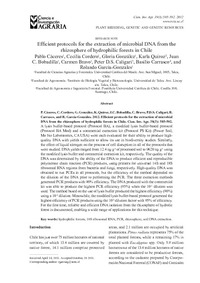Mostrar el registro sencillo de la publicación
Efficient protocols for the extraction of microbial DNA from the rhizosphere of hydrophilic forests in Chile
| dc.contributor.author | Cáceres-Ruz, Pablo | |
| dc.contributor.author | Cordero, Cecilia | |
| dc.contributor.author | González-Silva, Gloria | |
| dc.contributor.author | Quiroz, Karla | |
| dc.contributor.author | Bobadilla, Juan | |
| dc.contributor.author | Bravo-Castillo, Carmen | |
| dc.contributor.author | Caligari, Peter D. S. | |
| dc.contributor.author | Carrasco, Basilio | |
| dc.contributor.author | García-González, Rolando | |
| dc.date.accessioned | 2017-11-16T20:53:58Z | |
| dc.date.available | 2017-11-16T20:53:58Z | |
| dc.date.issued | 2012 | |
| dc.identifier.uri | http://repositorio.ucm.cl/handle/ucm/1269 | |
| dc.description.abstract | A lysis buffer-based protocol (Protocol BA), a modified lysis buffer-based protocol (Protocol BA Mod) and a commercial extraction kit (Protocol PS Kit) (Power Soil, Mo bio Laboratories, CA USA) were each evaluated for their ability to produce highquality DNA with yields sufficient to allow its use in biodiversity studies. Similarly, the effect of liquid nitrogen on the process of cell disruption in all of the protocols that were studied. DNA yields ranged from 12.4 ng g-1 of processed soil to 9620 ng g-1 using the modified lysis buffer and commercial extraction kit, respectively. The quality of the DNA was determined by the ability of the DNA to produce efficient and reproducible polymerase chain reaction (PCR) products, using primers for universal 16S and 18S ribosomal RNA regions from bacteria and fungi, respectively. High-quality DNA was obtained to run PCRs in all protocols, but the efficiency of the method depended on the dilution of the DNA prior to performing the PCR. The three extraction methods generated PCR products with 90% efficiency. The DNA produced with the commercial kit was able to produce the highest PCR efficiency (95%) when the 10-1 dilution was used. The method based on the use of lysis buffer produced the highest efficiency (90%) using a 10-2 dilution. Meanwhile, the modified lysis buffer-based protocol generated the highest efficiency of PCR products using the 10-3 dilution factor with 95% of efficiency. For the first time, reliable and efficient DNA isolation from the rhizosphere of hydrolic forest is documented, enabling a wide range of applications for this technique. | es_CL |
| dc.language.iso | en | es_CL |
| dc.rights | Atribución-NoComercial-SinDerivadas 3.0 Chile | * |
| dc.rights.uri | http://creativecommons.org/licenses/by-nc-nd/3.0/cl/ | * |
| dc.source | Ciencia e Investigación Agraria, 39(3), 585-592 | es_CL |
| dc.subject | Hydrophilic forests | es_CL |
| dc.subject | 16S ribosomal RNA | es_CL |
| dc.subject | PCR | es_CL |
| dc.subject | Rhizosphere | es_CL |
| dc.subject | Soil DNA extraction | es_CL |
| dc.title | Efficient protocols for the extraction of microbial DNA from the rhizosphere of hydrophilic forests in Chile | es_CL |
| dc.type | Article | es_CL |
| dc.ucm.facultad | Facultad de Ciencias Agrarias y Forestales | es_CL |
| dc.ucm.indexacion | Scopus | es_CL |
| dc.ucm.indexacion | Isi | es_CL |
| dc.ucm.indexacion | Scielo | es_CL |
| dc.ucm.doi | dx.doi.org/10.4067/S0718-16202012000300018 | es_CL |



